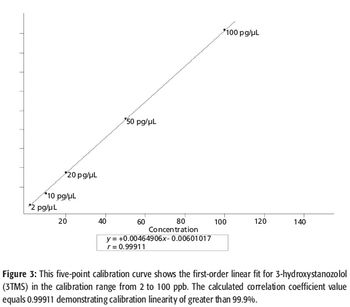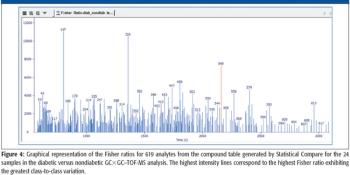
Gas chromatography with electron ionization and mass spectrometry (GC–EI-MS) detection is a workhorse among analytical techniques in metabolomics. A major challenge in the utilization of GC–EI-MS in metabolomics is the identification of unknowns.

Gas chromatography with electron ionization and mass spectrometry (GC–EI-MS) detection is a workhorse among analytical techniques in metabolomics. A major challenge in the utilization of GC–EI-MS in metabolomics is the identification of unknowns.

The misuse of androgenic anabolic steroids in sports was banned in 1976 by the International Olympic Committee and global sports community. The illegal use of anabolic steroids has reached disturbing levels worldwide. This worldwide problem is fueled partially by an ever-increasing demand for better athletic performance. The World Anti-Doping Agency has formulated strict guidelines for minimum allowable concentrations of exogenous anabolic steroids and their metabolites. The standard test methods for doping control are analyzed in urine samples with trimethyl-silyl derivatization. Urine is a complex and difficult biological matrix. This research shows the advantages of using comprehensive two-dimensional gas chromatography–time-of-flight-mass spectrometry (GCÃ-GC–TOF-MS) and illustrates the capability of GCÃ-GC-TOF-MS to be an effective instrumental option for antidoping control screening.

Two-dimensional gas chromatography–time-of-flight mass spectrometry (GCÃ-GC–TOF-MS) analysis has emerged as one of the technologies of choice for the analysis of small metabolite profiles. The results of these analyses produce substantial quantities of data that can be extremely time-consuming and labor-intensive for the analyst to interpret. New software provides a tool for the scientist to use as a data-mining strategy to find significant results from large, complex data sets. This proof of concept research was conducted using comprehensive GCÃ-GC–TOF-MS to elucidate the small-molecule metabolite profiles of diabetic and nondiabetic urine in search of key differences between disease-state and nondisease-state individuals.

Illegal drug use worldwide is at an all-time high. There is a crucial need for fast and accurate analysis to positively identify suspected drugs in criminal investigations. Gas chromatography combined with time-of-flight mass spectrometry (GC–TOFMS) can be a valuable tool for drug testing in forensic crime laboratories. Method development and GC–TOFMS experimentation was conducted in cooperation with a local crime laboratory. The laboratory testing presented will illustrate highly efficient methods and data developed for crime labs that assist in the battle against illegal drugs. Many drug classes have chemical properties that present particular analytical challenges, such as poor detector response, chemical lability, or poor chromatographic peak shape. This article presents GC–TOFMS methods developed for several major drug classes and chemical functionalities. The major drugs included in the initial method development are methamphetamine, ecstasy, and heroin. Robust and accurate..

Gas chromatography and comprehensive two-dimensional gas chromatography with time-of-flight mass spectrometry (GC–TOFMS and GCxGC–TOFMS) were utilized to develop trace-level calibration curves in brewed green tea spiked with organochlorine and organophosphorus pesticide standards. A sensitive and robust calibration curve was developed from 10 to 500 parts per trillion (ppt), which allowed quantitative results to be determined for organochlorine–organophosphorus pesticides in brewed green tea. Exceptional limits of detection were achieved by GC–TOFMS and GCxGC–TOFMS at or below 10 ppt (solution concentration) for all but one of the pesticides. Stir bar sorption extraction (SBSE) was utilized to isolate the pesticide components from brewed green tea samples prior to analysis by GC–TOFMS and GCxGC–TOFMS. Different types of green tea were analyzed qualitatively by SBSE and GC–TOFMS with subsequent quantification for organochlorine–organophosphorus..

Published: May 1st 2010 | Updated:

Published: July 1st 2008 | Updated:

Published: March 1st 2008 | Updated: